AT40 = 63.6% of stocks are trading above their respective 40-day moving averages (DMAs)
AT200 = 54.9% of stocks are trading above their respective 200DMAs
VIX = 9.6
Short-term Trading Call: cautiously bullish
Commentary
The stock market stubbornly held onto its bullish positioning despite the tumble of one of its biggest stalwarts: Apple (AAPL).
AAPL fell 5.0% for the week. In the process the stock printed a bearish breakdown below support at its 50-day moving average (DMA) and completely reversed the bullish breakout from the August earnings gap up. The resulting pattern looks like a top. Buyers finally delivered a reprieve of sorts on Friday after AAPL plunged well below its lower-Bollinger Band and created a short-term oversold condition. The bounce from the lows created a hammer that needs follow-up buying for confirmation.
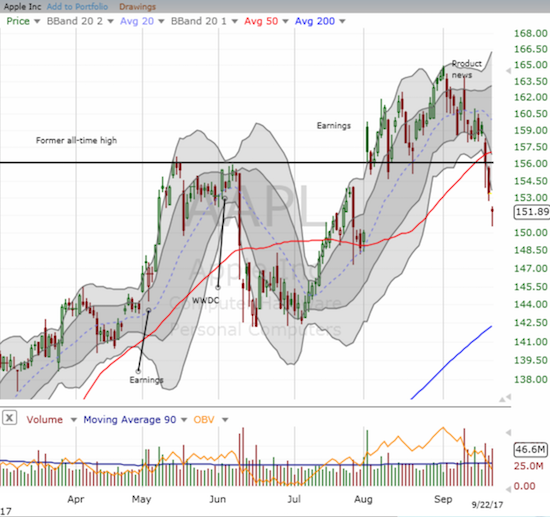
I cut AAPL some slack and stuck to the current trading strategy of having call options in play on a weekly basis. Needless to say, I had to watch one tranche of calls expire worthless last week. My second tranche timed for the coming week was laid to waste. My third tranche, my last until AAPL’s bullish flair returns, should be well positioned as I bought it when AAPL flirted with $150 in deeply oversold territory. If not for the weekly call trading strategy, I would have flagged AAPL as a potential short with the 50DMA breakdown last Wednesday. Moreover, AAPL’s product rollout is in a strange and complicated place with the coming introduction of the iPhone 8 which will be followed in another month by the more powerful iPhone X.
The rest of the market is doing its best to ignore AAPL’s latest travails. While the S&P 500 (SPY) ended the week around where it started, the index made more all-time highs in between. The upper-Bollinger Bands (BBs) are clinging to their bid to guide the index ever higher.
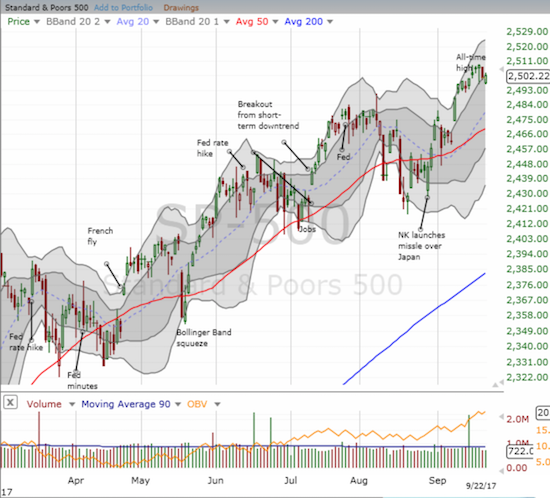
AAPL made its presence felt in the tech-laden NASDAQ and the PowerShares QQQ ETF (QQQ). On Friday, the NASDAQ managed to bounce off uptrending 20DMA support. AAPL’s impact was much greater on QQQ which barely escaped with a bounce off uptrending 50DMA support.

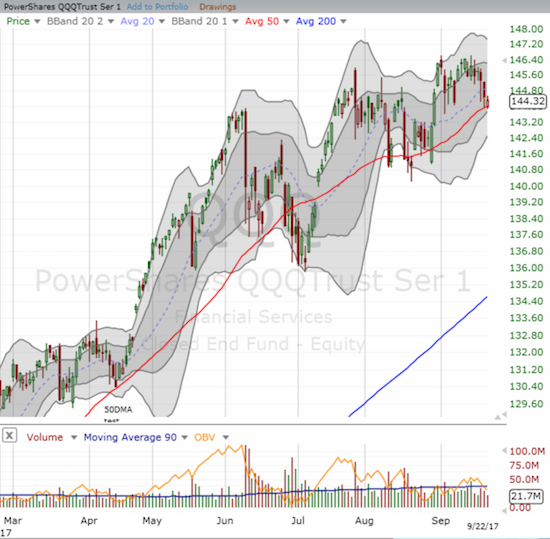
The volatility index is doing its best to make new history. Starting September 11th, the VIX closed with a loss all but one day. The march is in inches, but the VIX is now within sight of a 24-year low and perhaps an all-time closing low. This bullish behavior is all the more remarkable considering the continuing heating of wartime rhetoric between North Korea and the U.S. That rhetoric, and the season of the calendar, keep me rotating into call options on ProShares Ultra VIX Short-Term Futures (UVXY).
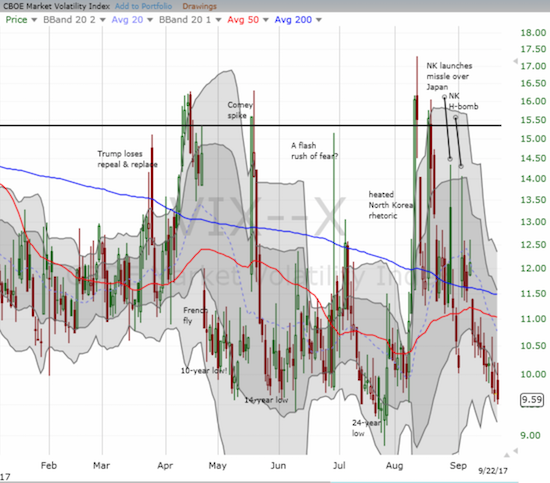
AT40 (T2108), the percentage of stocks trading above their respective 40DMAs, held steady for the week in the low to mid-60s. So with one eye on current conditions I keep the short-term trading call on cautiously bullish. With another eye looking around broadly, I see plenty of reason to BE cautious. My trades last week reflected this mix.
Tesla (TSLA)
TSLA was hit by an analyst downgrade last week and sellers stepped right in. After it looked like the selling would come to a quick end at the bottom of the upper-BB channel, I bought a call option in anticipation of a rapid bounce. For a brief moment the next day the trade looked smart. When sellers took TSLA below the channel, I quickly reached for a put option to hedge my position. TSLA closed an ugly week with a 4.2% loss on Friday. I took profits on the put to pay for the call option but left some good money on the table.
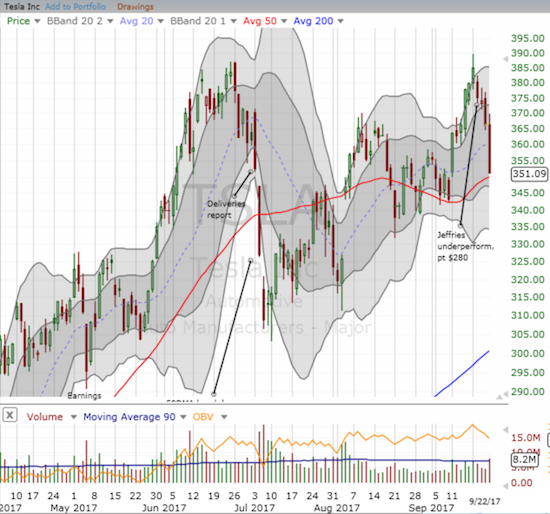
Chipotle Mexican Grill (CMG)
CMG started the week with a nasty tumble. I pounced on the decline as a fresh buying opportunity. Yet, when CMG cracked the previous low I reached for put options in preparation for what then looked like a bigger sell-off. Buyers soon rushed in and turned the day into a bullish looking like “hammer.” I can only imagine that sellers took out stops at the previous lows and/or the $300 level. The subsequent rebound signals once again that sellers are exhausting themselves. It is just too bad I did not stick to my bullish bottoming thesis: I should have waited for confirmation of selling pressure before buying the put options. On Friday I salvaged some of the value of the call option and watched the put options get laid to rest – just another one of those lessons learned. The difference here from the TSLA trade is that I do not have a standing bullish thesis on TSLA.
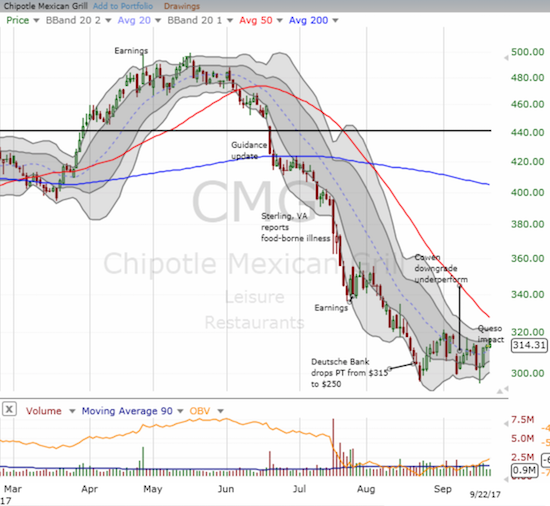
Autozone (AZO) and O’Reilly Automotive (ORLY)
The initial response to Autozone’s earnings was bullish as buyers stepped in right at the open. Hoping to participate in the confirmation of my bullish call on AZO, I placed a low ball offer for a call option hoping the order might fill as post-earnings implied volatility imploded. Instead, the stock quickly reversed, and my bid was met as sellers in the stock rushed for the exits. The proximate cause was a series of dour comments from the CEO in his introductory remarks during the conference call. Here is a sample from the Seeking Alpa transcript:
“There are certain factors present today some macro and others that relate to actions we have taken as part of our long-term strategy that have created challenges to us delivering the same level of profitability growth that we have been delivering.
We intentionally made the decision to invest in our business at an accelerated rate in inventory, capital expenditures and operating expenses. Unfortunately, as we increased our investment profile, our sales have been slower than we would have thought due to poor performance in several of our weather-sensitive categories and our multiple frequency of delivery initiative did not generate the benefits yet that we expected.
Additionally, as our commercial program openings have slowed, our overall commercial sales growth has declined as well. Simultaneously, we faced several other pressure points. Over the last year, we’ve experienced accelerated pressure on wages significantly more than I have experienced in my nearly 23 years of Autozone. Some of this is attributable to regulatory changes in certain states and municipalities, while the balance and probably the larger portion is being driven by general market pressures with lower unemployment and some specific actions taken in recent years by other retailers.
The regulatory changes are going to continue as evidenced by the areas that have passed legislation to increase their wages substantially over the next few years. Additionally, we are experiencing increased levels of shrink in our interest expense after years of lower rates is beginning to increase.
The collective combination of these factors have significantly hampered our earnings per share growth.”
ORLY first soared and then sold off in sympathy with AZO. I thought the selling was just the buying opportunity I was looking for and I snatched some call options. In the heat of the moment, I neglected to adjust (or cancel) my order on AZO. That order filled to my initial chagrin. The next day, buyers swiftly returned to AZO, and I quickly took some nice profits (sometimes it is better to be lucky than good). Per the chart below, I clearly should have held on! I am at least still holding my now profitable call options on ORLY.
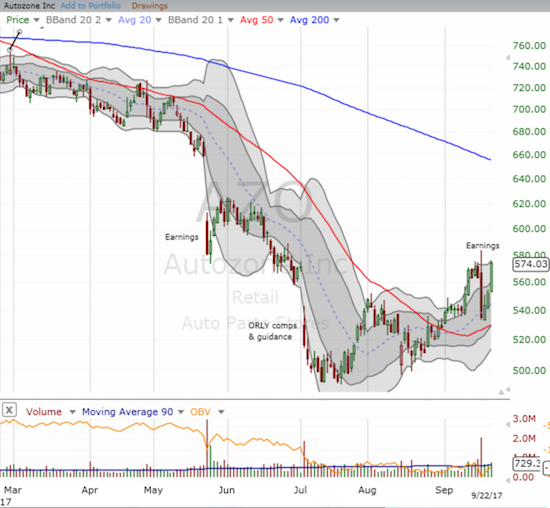

First Solar (FSLR)
I pointed out the bullish breakout in FSLR in my last Above the 40 post. Much to my delight, I got a chance to (re)participate in the stock’s run-up when it proceeded to reverse the breakout and test 50DMA support. On Friday, fresh news about solar tariffs reignited the stock for a gain that almost reached 7% at one point. Given tariff-related moves can be oh so capricious, I decided to take my profits.
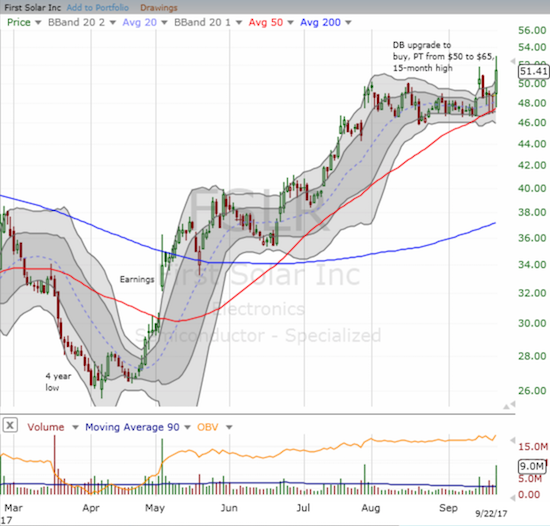
Intercept Pharmaceuticals (ICPT)
I have not written about ICPT for a long time (click here to see related references). Suffice to say that I am little surprised that the stock finally completed a reversal of 2014’s remarkable run-up: in two days ICPT soared from $72.39 to $275.87 and to $445.83. The stock has not closed higher since.
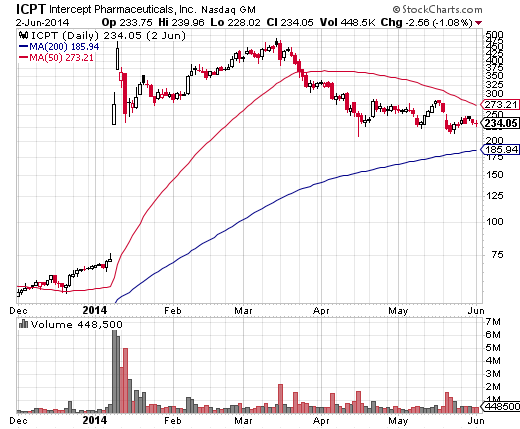
I was slow on the uptake when ICPT experienced a post-earnings breakdown below its 50 and 200DMAs following July earnings. That breakdown received confirmation when ICPT met stiff resistance at its converged 50/200DMAs earlier this month. The confirmation of a bearish turn of events came on the big gap down the very next day. I was STILL slow to move when ICPT sold off anew on Thursday after the FDA issued a warning letter. I FINALLY made a trade on Friday in the middle of fresh selling. My lateness forced me to combine a small short on the stock with a call option to cover any upside surprises. ICPT is obviously trading well below its lower-BB and subject to a sharp relief rally. In such a case, I will likely add to my small short position. I learned a fresh lesson in following the scent of the technicals…
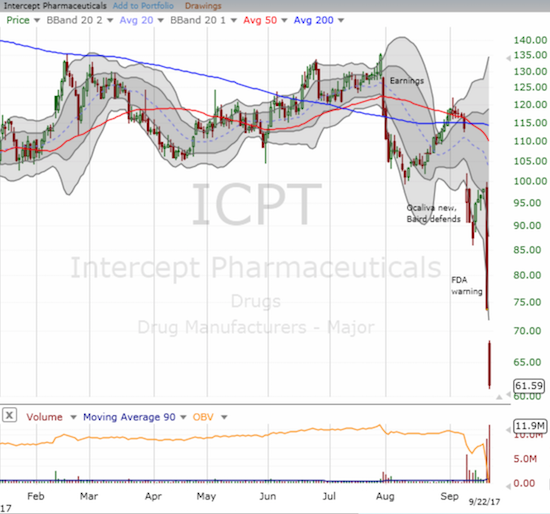
U.S. Steel (X)
I have followed U.S. Steel all the way up its recovery from the May lows. In early June, I wrote about the bullish second half thesis on steel stocks like X. Buying the dips and selling the rallies worked until last week. U.S. Steel finally broke down below its uptrending 50DMA in a move that seems to signal the end of the rally. I will hang onto my latest tranche of call options (expiration in October) given the thesis, but I will add no more until X gets back its bullish strut. Note that a July downgrade from Citi dragged X to this very same spot.
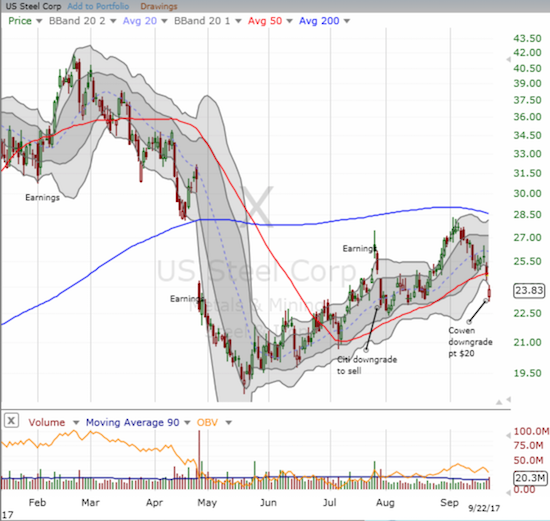
Ulta Beauty (ULTA)
I am still waiting for my next trade in ULTA. The current slide down the 20DMA validates my exit the moment ULTA sold downward from this point of resistance. I am looking for buyers to come back to life around $216 where ULTA will meet its lower-BB.
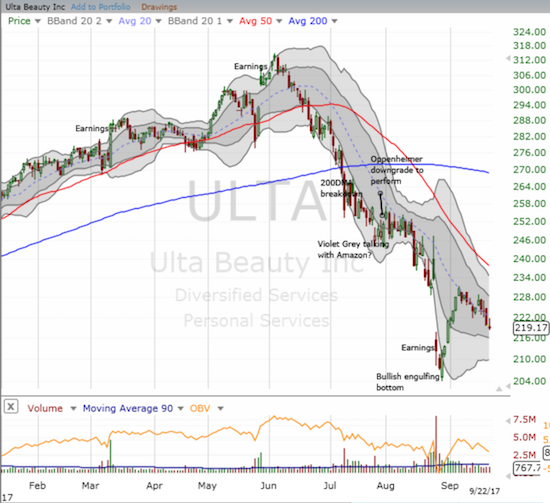
KB Home (KBH)
Friday was a WILD day for KBH. In the first 25 minutes of trading, the stock soared 6.7%. By the “witching hour” of 2:30pm Eastern, KBH lost that entire gain. Buyers barely dragged the stock back to a fractional gain at the close. According to briefing.com, M&A speculation was swirling around the company.
The move befitted a bizarre news week for KBH. Earlier in the week, news broke of a neighborly spat between KBH CEO Jeffrey Mezger and the now increasingly notorious actress and comedienne Kathy Griffin and her live-in boyfriend. Mezger hurled enough invectives to earn himself a reprimand from KBH’s board in the form of a lost bonus. Griffin and her boyfriend moved in just a year ago and have already filed five noise complaints with the police about Mezger’s household. KBH reports earnings this coming week on the 28th. I will be ALL ears.
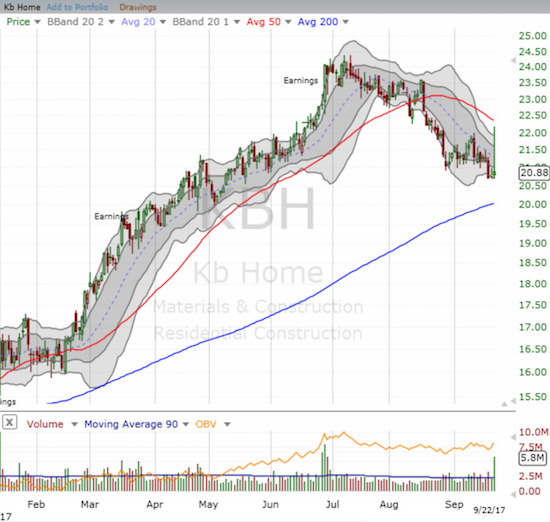
In other trades: I sold my U.S. Concrete (USCR) call option as the stock bounced perfectly off 200DMA support and slammed into 50DMA resistance. I bought the breakout for Zynga (ZNGA) that I pointed out last week. I executed the Rio Tinto (RIO) versus BHP Billiton (BHP) pairs trade, but I am already reconsidering given a ballooning buyback and dividend from RIO.
— – —
FOLLOW Dr. Duru’s commentary on financial markets via email, StockTwits, Twitter, and even Instagram!
“Above the 40” uses the percentage of stocks trading above their respective 40-day moving averages (DMAs) to assess the technical health of the stock market and to identify extremes in market sentiment that are likely to reverse. Abbreviated as AT40, Above the 40 is an alternative label for “T2108” which was created by Worden. Learn more about T2108 on my T2108 Resource Page. AT200, or T2107, measures the percentage of stocks trading above their respective 200DMAs.
Active AT40 (T2108) periods: Day #397 over 20%, Day #211 over 30%, Day #11 over 40%, Day #10 over 50%, Day #6 over 60% (overperiod), Day #157 under 70%
Daily AT40 (T2108)

Black line: AT40 (T2108) (% measured on the right)
Red line: Overbought threshold (70%); Blue line: Oversold threshold (20%)
Weekly AT40 (T2108)

*All charts created using freestockcharts.com unless otherwise stated
The charts above are my LATEST updates independent of the date of this given AT40 post. For my latest AT40 post click here.
Related links:
The T2108 Resource Page
You can follow real-time T2108 commentary on twitter using the #T2108 or #AT40 hashtags. T2108-related trades and other trades are occasionally posted on twitter using the #120trade hashtag.
Be careful out there!
Full disclosure: long ORLY call options, long X call options, short ICPT and long call options, long AAPL call options, long TSLA call option, long UVXY call options, long ZNGA, long BHP call options and RIO put options
*Charting notes: FreeStockCharts.com uses midnight U.S. Eastern time as the close for currencies. Stock prices are not adjusted for dividends.
